This lesson will introduce you all elements of playing slide guitar, including styles, components and tunings. Famous Slide Guitar players are also introduced.
Introduction to slide guitar
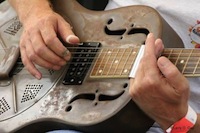 Add Slide guitar to your repertoire for an exciting new sound
Add Slide guitar to your repertoire for an exciting new sound
Slide guitar is a form of playing that involves using an object to slide into a note from below (more common) or above the target pitch. Slides come in different sizes, thickness, and materials, the most common being glass or metal.
Slide Guitar Fundamentals
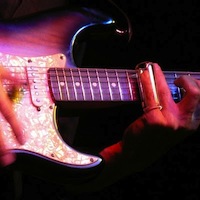 Here you see a glass slide worn on the pinky with the ring finger dampening.
Here you see a glass slide worn on the pinky with the ring finger dampening.
Usually slides are designed to fit over a fret hand finger, although they can be in a metal bar shape and held between the fingers. Most players wear the slide on the pinky of the fret hand. This allows the other fingers to be used to fret notes, as well as incorporating the slide for more variation, and also allows for better dampening behind the slide. The dampening technique is crucial to the sound, as it reduces unwanted overtones and ringing of the notes, for a more muted sound. Do not push the strings down onto the fretboard with the slide. Simply glide the slide over the strings. It is best to have a guitar setup with high action (strings are higher off the fretboard than normal), to avoid having the strings bang up against the metal fret wires. A metal nut can be used to achieve the proper string height, but should be installed on a guitar designated for slide playing. This kind of moderation can make the guitar useless for normal fret hand playing.
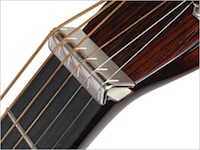 A metal nut makes slide guitar easier but makes normal fret playing (nearly) impossible.
A metal nut makes slide guitar easier but makes normal fret playing (nearly) impossible.
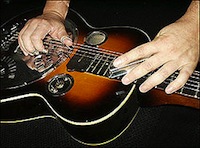 Here you see lap style slide guitar
Here you see lap style slide guitar
Proper intonation
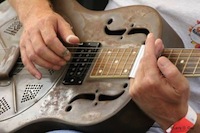
In order to achieve the proper intonation (the note sounding in pitch), it is necessary to bring the slide to rest on the far fret wire (fret wire closest to the guitar body) of the pitch you are trying to achieve. This is similar to playing a fretless instrument. You must be in exactly the the right position to sound the note correctly. Your ear will come into play here. Just a slight deviation from the right spot will result in a flat or sharp note.
Slide Guitar Tunings
Many players employ 'open tunings' when playing slide guitar. This allows an entire major chord to be formed by barring across one fret, ideal for this style, since the slide is easiest to incorporate when held straight across the neck. Common open tunings are: G Major, D Major (slack tunings, since the affected strings are tuned down to form the chord), and E Major, A Major (the affected strings are tuned higher to form the chord).
Standard tuning (low to high): E A D G B E (Eddy Ate Dynamite Good Bye Eddy, great way to remember the string names)
Open G Major (low to high): D G D G B D
Open D Major (low to high): D A D F sharp A D
Open E Major (low to high): E B E G sharp B E
Open A Major (low to high): E A E A C sharp E
Masters of Slide Guitar
Even though slide guitar shows up in all genres of music, it is very prevalent in blues. Some very famous blues slide players include:
Elmore James
Robert Johnson
Duane Allman
Muddy Waters
Mick Taylor
Billy Gibbons
Ry Cooder
Ted Drozdowski put together a great article entitled '10 Giants Of Slide Guitar' for the Gibson guitar site.